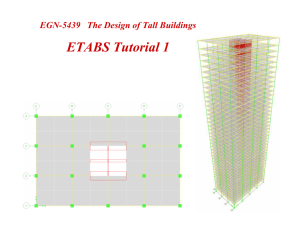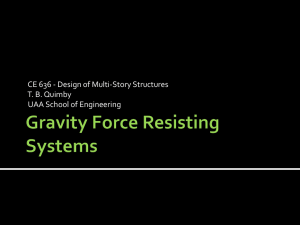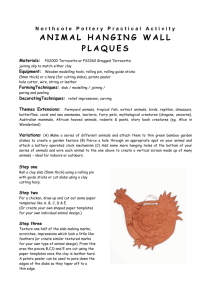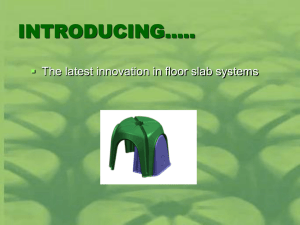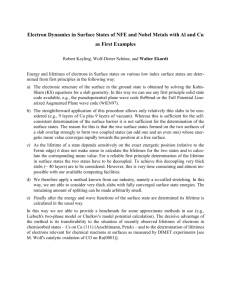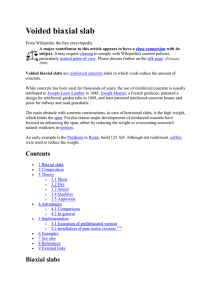this article
advertisement
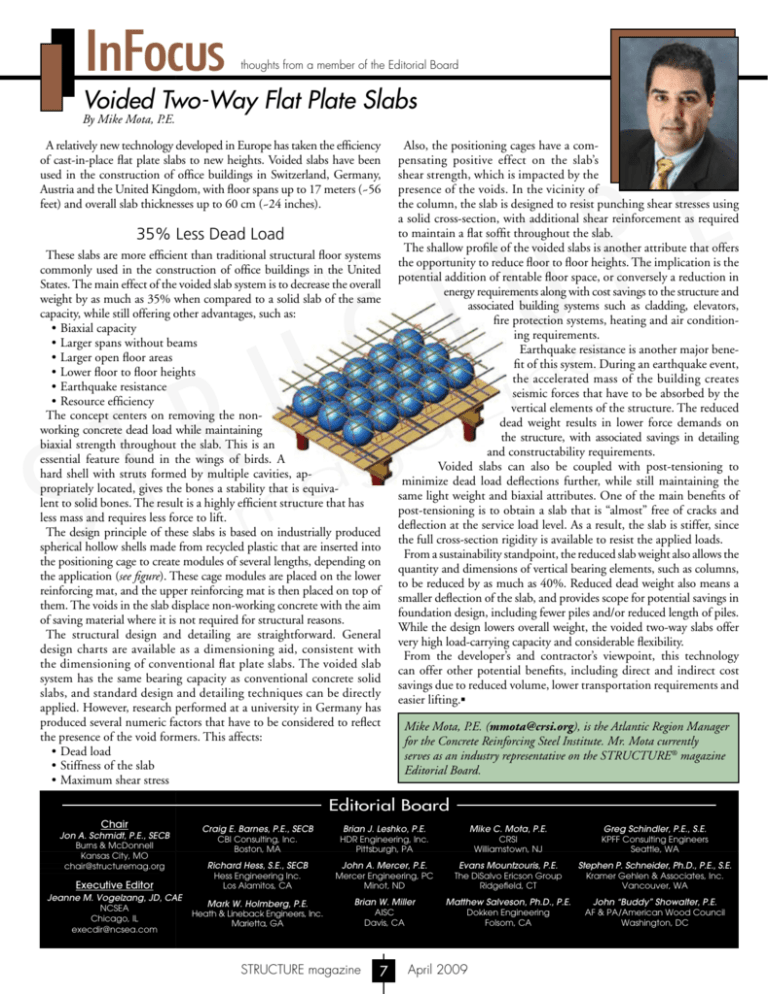
InFocus thoughts from a member of the Editorial Board Voided Two-Way Flat Plate Slabs By Mike Mota, P.E. A relatively new technology developed in Europe has taken the efficiency of cast-in-place flat plate slabs to new heights. Voided slabs have been used in the construction of office buildings in Switzerland, Germany, Austria and the United Kingdom, with floor spans up to 17 meters (~56 feet) and overall slab thicknesses up to 60 cm (~24 inches). 35% Less Dead Load These slabs are more efficient than traditional structural floor systems ght commonly used in the construction of office buildings in the riUnited y p States. The main effect of the voided slab system is to decrease Co the overall weight by as much as 35% when compared to a solid slab of the same capacity, while still offering other advantages, such as: •Biaxial capacity •Larger spans without beams •Larger open floor areas •Lower floor to floor heights •Earthquake resistance •Resource efficiency The concept centers on removing the nonworking concrete dead load while maintaining biaxial strength throughout the slab. This is an essential feature found in the wings of birds. A hard shell with struts formed by multiple cavities, appropriately located, gives the bones a stability that is equivalent to solid bones. The result is a highly efficient structure that has less mass and requires less force to lift. The design principle of these slabs is based on industrially produced spherical hollow shells made from recycled plastic that are inserted into the positioning cage to create modules of several lengths, depending on the application (see figure). These cage modules are placed on the lower reinforcing mat, and the upper reinforcing mat is then placed on top of them. The voids in the slab displace non-working concrete with the aim of saving material where it is not required for structural reasons. The structural design and detailing are straightforward. General design charts are available as a dimensioning aid, consistent with the dimensioning of conventional flat plate slabs. The voided slab system has the same bearing capacity as conventional concrete solid slabs, and standard design and detailing techniques can be directly applied. However, research performed at a university in Germany has produced several numeric factors that have to be considered to reflect the presence of the void formers. This affects: •Dead load •Stiffness of the slab •Maximum shear stress R T S ® Also, the positioning cages have a compensating positive effect on the slab’s shear strength, which is impacted by the presence of the voids. In the vicinity of the column, the slab is designed to resist punching shear stresses using a solid cross-section, with additional shear reinforcement as required to maintain a flat soffit throughout the slab. The shallow profile of the voided slabs is another attribute that offers the opportunity to reduce floor to floor heights. The implication is the potential addition of rentable floor space, or conversely a reduction in energy requirements along with cost savings to the structure and associated building systems such as cladding, elevators, fire protection systems, heating and air conditioning requirements. Earthquake resistance is another major benefit of this system. During an earthquake event, the accelerated mass of the building creates seismic forces that have to be absorbed by the vertical elements of the structure. The reduced dead weight results in lower force demands on the structure, with associated savings in detailing and constructability requirements. Voided slabs can also be coupled with post-tensioning to minimize dead load deflections further, while still maintaining the same light weight and biaxial attributes. One of the main benefits of post-tensioning is to obtain a slab that is “almost” free of cracks and deflection at the service load level. As a result, the slab is stiffer, since the full cross-section rigidity is available to resist the applied loads. From a sustainability standpoint, the reduced slab weight also allows the quantity and dimensions of vertical bearing elements, such as columns, to be reduced by as much as 40%. Reduced dead weight also means a smaller deflection of the slab, and provides scope for potential savings in foundation design, including fewer piles and/or reduced length of piles. While the design lowers overall weight, the voided two-way slabs offer very high load-carrying capacity and considerable flexibility. From the developer’s and contractor’s viewpoint, this technology can offer other potential benefits, including direct and indirect cost savings due to reduced volume, lower transportation requirements and easier lifting.▪ U T C U m e n i z a g a E R Mike Mota, P.E. (mmota@crsi.org), is the Atlantic Region Manager for the Concrete Reinforcing Steel Institute. Mr. Mota currently serves as an industry representative on the STRUCTURE® magazine Editorial Board. Editorial Board Chair Jon A. Schmidt, P.E., SECB Burns & McDonnell Kansas City, MO chair@structuremag.org Executive Editor Jeanne M. Vogelzang, JD, CAE NCSEA Chicago, IL execdir@ncsea.com Craig E. Barnes, P.E., SECB CBI Consulting, Inc. Boston, MA Brian J. Leshko, P.E. HDR Engineering, Inc. Pittsburgh, PA Mike C. Mota, P.E. CRSI Williamstown, NJ Greg Schindler, P.E., S.E. KPFF Consulting Engineers Seattle, WA Richard Hess, S.E., SECB Hess Engineering Inc. Los Alamitos, CA John A. Mercer, P.E. Mercer Engineering, PC Minot, ND Evans Mountzouris, P.E. The DiSalvo Ericson Group Ridgefield, CT Stephen P. Schneider, Ph.D., P.E., S.E. Kramer Gehlen & Associates, Inc. Vancouver, WA Mark W. Holmberg, P.E. Heath & Lineback Engineers, Inc. Marietta, GA Brian W. Miller AISC Davis, CA Matthew Salveson, Ph.D., P.E. Dokken Engineering Folsom, CA John “Buddy” Showalter, P.E. AF & PA/American Wood Council Washington, DC STRUCTURE magazine 7 April 2009
